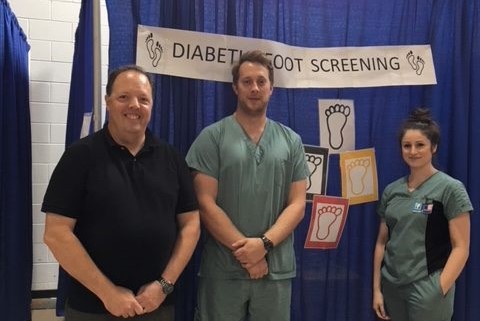
On September 27, 2018, the Rama Health Fair took place at the Mnjikaning Arena Sports Ki (MASK) in Rama, Ontario. This annual event, hosted by the Chippewas of Rama First Nations, is dedicated to health promotion, allowing individuals from the area to learn more about the available health services, outreach programs and activities in their community.
The yearly health fair has roots that date back to the origins of the Chippewa of Rama First Nation. Rama, located 15 minutes north-east of Orillia bordering Lake Couchiching, is recognized for its harsh winter conditions. Well known for their hospitality, the Chippewas shared their knowledge and medicines with early settlers of the area, enabling them to survive their first difficult years in a new and unknown land. The tradition of hospitality and continuing education remains to this day.
Alongside local registered Chiropodist Ed Moloy, third-year Chiropody students Taite Grant and Brendan Dunn were able to take part in this year’s fair. Many individuals curious about their foot care stopped by the booth to learn more about diabetes, footwear, orthoses and more. The day provided an excellent opportunity to gain insight into care and health education, specifically regarding the diabetic population of the First Nations community.
In the Rama area, the prevalence of diabetes ranges from 2.7–19%, which is three to five times higher than non-Aboriginal cohorts. Additionally, a parallel increase in diabetic complications such as wounds, infections and even amputations can occur. It was the team’s primary objective to educate the community on diabetes and preventive measures before the latter-end of complications occur.
A special emphasis this year was placed on activity. This took the form of various demonstrations, local health care practitioners, booths and diabetic foot screenings. As Chiropodists, activity is something often emphasized with patients, whether it be increasing activity level or getting them back to their favourite sport. Living and maintaining a healthy lifestyle will further promote an increase in overall health, as well as decrease risks to critical body functions.
Overall, this was an excellent opportunity for the students to gain insight into an area that many of them may not experience during their time at The Michener Institute.
For more information on the Indigenous population and diabetes, check out the Indigenous Diabetes Health Circle website. This initiative promotes holistic wellness models that build on traditional teachings to develop programs, education and resources for diabetics.